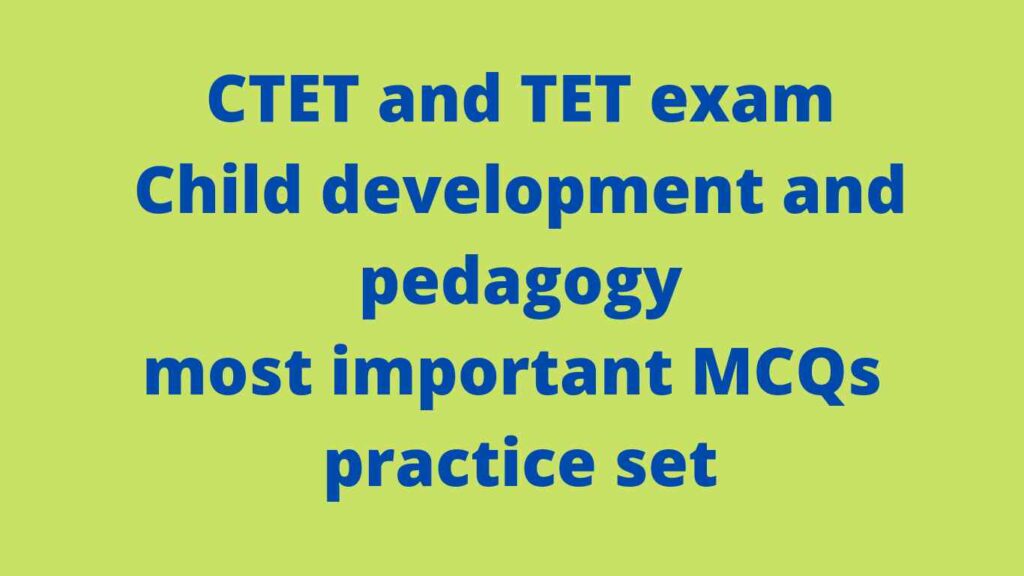Child development and pedagogy MCQs
CTET and any Tet exam preparation: In this article we are covering most important multiple choice questions of child development and pedagogy for paper I and II .

1. Question:- Sequence of development among children from birth to adolescence is
A. Concrete abstract sensory
B. Abstract century concrete
C. Sensory concrete abstract
D. Abstract concrete Sensory
Answer:- C
2. Question:- Problem solving abilities can be facilitated by
A. Focusing on drill and practice
B. Encouraging use of analogies
C. Generating fear among children
D. Encouraging fixed process of solving the problems
Answer:- B
3. Question:- During a task, a girl is talking to herself about ways she can proceed on the task. According to lev vygotsky’s ideas on language and thought; this kind of private speech is sign of
A. Psychological disorder
B. Self regulation
C. Cognitive immaturity
D. Ego centricism
Answer:- B
4. Question. After getting hurt during a play activity a boy started crying. Seeing this his father responded. Don’t behave like girls boys don’t cry this statement by the father
A. Reflects gender stereotype
B. Reduce gender bias
C. Promote gender equality
D. Challenges gender stereotype
Answer. A
5. Question:- Individual differences in a progressive classroom should be treated as
A. Criteria for making ability based groups
B. A failure on the part of teacher
C. Important for planning of teaching learning process
D. A hindrance of the process of learning
Answer. C
6. Question:- In order to address the needs of students who are facing learning difficulties, a teacher should not
A. Do individualised educational planning
B. Use multiple audio visual aids
C. Practice rigid structure for pedagogy and assessment
D. Use constructive pedagogical approaches
Answer. C
7. Question:- ________ is the primary identifying feature of creativity.
A. Hyperactivity
B. Low comprehension
C. Inattentiveness
D. Divergent thinking
Answer. D
8. Question:- Shame_______ .
A. Has no relation to cognitive
B. Is very effective to motivate the children to learn
C. Should be generated frequently in teaching learning process.
D. Can have negative impact on cognition .
Answer. D
9. Question:- Motivation to learn can be sustained by
A. Giving very easy task to children
B. Focusing on mastery orientated goals
C. Punishing the child
D. Focusing on rote memorization
Answer. B
10. Question:- Theory of multiple intelligence emphasized that
A. There are several forms of intelligence
B. Intelligence quotient (IQ) can be measured only by objective test
C. There are no individual differences in intelligence
D. Intelligence in one domain ensures intelligence in all other domains
Answer. A
11. Question:- Pre-oprational stage in Jean Piaget’s theory of cognitive development chracterizes
A. Development of extract thinking
B. Hypothetico deductive thinking
C. Centration in thought
D. Ability to conserve and seriate objects
Answer. C
12. Question:- In a progressive classroom
A. Ample opportunities should be provided for construction of knowledge
B. Students should be labelled on the basis of their academic scores
C. A teacher should follow fixed curriculum
D. The emphasize should be on compitition among children
Answer. A
13. Question:- In the theory of cognitive development, Jean Piaget explain cognitive structure in terms of
A. Zone of proximal development
B. Stimulus response association
C. Schema
D. Psychological tools
Answer. C
14. Question:- Individual differences in development of children can be attributed to
A. Heredity only
B. Niether heredity nor environment
C. Interplay of heredity and environment
D. Environment only
Answer. C
15. Question:- In order to address learners from diverse backgrounds, a teacher should
A. Draw examples from diverse setting
B. Use statements that strengthen nagetive stereotype
C. Avoid talking about aspects related to diversity
D. Use standardized assessment for all
Answer. D
Explore more content:-
CTET social science previous year MCQs solution
Social studies solved question paper CTET paper II
16. Question:- According to Lawrence kohlberg’s theory, “performing an act and doing something because others aproved it”. Represents_______ stage of morality.
A. Formal conventional
B. Pre- conventional
C. Conventional
D. Post conventional
Answer. C
17. Question:- It is difficult for children to learn when
A. Content is represented through multiple ways
B. Learning is socially contextualised
C. Information is presented in disconnected chunks
D. They are intrinsically motivated
Answer. C
18. Question:- after observing that students are struggling to proceed further on an ongoing activity, a teacher decides to provide cues and hints in form of what, why, how. According to Lev Vygotsky’s this strategy of teacher will
A. Cause withdrawal tendency among students
B. Be meaningless in learning process
C. At as a scaffold for learning
D. Demotivate the children to Learn
Answer. C
19. Question:- Constructivist view of learning suggests that children ________ construction of their own knowledge.
A. are solely dependent on adult for
B. play an active role in
C. are solely dependent on textbooks in
D. have no role to play in
Answer. B
20. Question:- In an inclusive classroom emphasize should be on
A. Undifferentiated instruction
B. Performance orientated goals
C. Providing opportunities aiming at maximizing potential of individual children
D. Segregation of students based on their social identity
Answer. C
21. Question :- Lev Vygotsky’s social, cultural perspective of learning emphasize importance of________ in the learning process.
A. Cultural tools
B. Motivation
C. Equilibration
D. Attribution
Answer. A
22. Question:- Which of the following statement is correct in context of development ?
A. Development occurs only through learning that takes place in school
B. Development occurs only during the period of childhood
C. Development has the same rate of growth across cultures for everyone
D. Development is multidimensional
Answer. D
23. Question:- According to right of person with disabilities act 2016. Which of the term is appropriate to use?
A. Students with crippled body
B. Students with physical disabilities
C. Handicapped students
D. Retarded students
Answer. B
24. Question:- Conceptual understanding among students is likely to improve in the settings which emphasize on
A. Competitions
B. Inquiry and dialogues
C. Textbook centric pedagogy
D. Frequent examination
Answer. B
25. Question:- Evaluation practices should aim at
A. Identification of high achievers for prize distribution
B. Segregation of students for ability based groups
C. Identifying students needs and requirements
D. Labelling of students
Answer. C
26. Question:- A teacher should analyse the various errors made by students on a given task because
A. Learning is solely based on correction of errors
B. She can decide degree of punishment accordingly
C. Understanding of errors are meaningful in the teaching- learning process
D. She can segregate those who made more errors in comparison to others
Answer. C
27. Question:- Best state of Learning is
A. Moderate arousal, no fear
B. No arousal, no fear
C. Low arousal, high fear
D. High arousal, high fear
Answer. A
28. Question:- Which of the following is most effective mode of teaching learning process?
A. Rote memorization of content
B. Exploration of relationship between concepts
C. Limitations and repetations
D. Observation without analysis
Answer. B
29. Question:- Which of the following is correct in context of socialization of children?
A. Peers are primary socialization agents and family is a secondary socialization agents
B. School is a secondary socialization agent and family is primary socialization agent
C. School is primary socialization agent and peers are secondary socialization agent
D. Family and mass media both are secondary socialization agent
Answer. B
30. Question:- Which of the following is not related to Child -centred teaching learning process ?
A. Emphasize on experiential learning
B. Emphasize on holistic development
C. Emphasize on Self-Learning
D. Emphasize on classroom learning
Answer. D
Question 31: What is the primary focus of the constructivist theory in child development?
a) Memorization of facts
b) Teacher-centered instruction
c) Active participation and hands-on learning
d) Strict behavior management
Answer:
c) Active participation and hands-on learning
Question 32: Which stage of Jean Piaget’s cognitive development theory is associated with the development of object permanence?
a) Sensorimotor
b) Preoperational
c) Concrete operational
d) Formal operational
Answer:
a) Sensorimotor
Question 33: In the context of Vygotsky’s sociocultural theory, what is the Zone of Proximal Development (ZPD)?
a) Activities a child can do independently
b) Tasks that are too difficult for a child
c) The range of tasks a child can do with the help of a more knowledgeable person
d) The stage of cognitive development reached by a child
Answer:
c) The range of tasks a child can do with the help of a more knowledgeable person
Question 34: Which of the following is a key principle of behaviorism in pedagogy?
a) Emphasizing self-directed learning
b) Reward and punishment influencing behavior
c) Promoting critical thinking skills
d) Fostering creativity in students
Answer:
b) Reward and punishment influencing behavior
Question 35: What is the importance of scaffolding in the context of teaching and learning?
a) Providing physical support to students
b) Gradually reducing support as students become more competent
c) Encouraging competition among students
d) Ignoring individual learning needs
Answer:
b) Gradually reducing support as students become more competent
Question 36: According to Erik Erikson’s theory of psychosocial development, which stage occurs during early childhood and involves developing a sense of autonomy versus shame and doubt?
a) Initiative vs. Guilt
b) Autonomy vs. Shame and Doubt
c) Trust vs. Mistrust
d) Industry vs. inferiority
Answer:
b) Autonomy vs. Shame and Doubt
Question 37: What does Howard Gardner’s theory of multiple intelligences propose?
a) Intelligence is a single, general ability.
b) There are different types of intelligence, such as linguistic, logical-mathematical, and spatial.
c) Intelligence is determined solely by genetics.
d) Emotional intelligence is the only significant form of intelligence.
Answer:
b) There are different types of intelligence, such as linguistic, logical-mathematical and spatial.
Question 38: According to Lawrence Kohlberg’s theory of moral development, which level is characterized by making decisions based on social norms and laws?
a)Preconventional
b) Conventional
c) Postconventional
d) Autonomous
Answer:
b) Conventional
Question 39: What is the primary goal of inclusion in education?
a) Segregating students based on ability
b) Excluding students with special needs
c) Providing equal opportunities for all students, including those with disabilities
d) Focusing only on academic achievements
Answer:
c) Providing equal opportunities for all students, including those with disabilities
Question 40:
According to Maslow’s hierarchy of needs, what must be satisfied first before a student can focus on academic achievement?
a) Esteem needs
b) Self-actualization needs
c) Safety needs
d) Belongingness and love needs
Answer:
c) Safety needs
Read also these articles:-
Featured articles:-
Social sharing ⬇️

